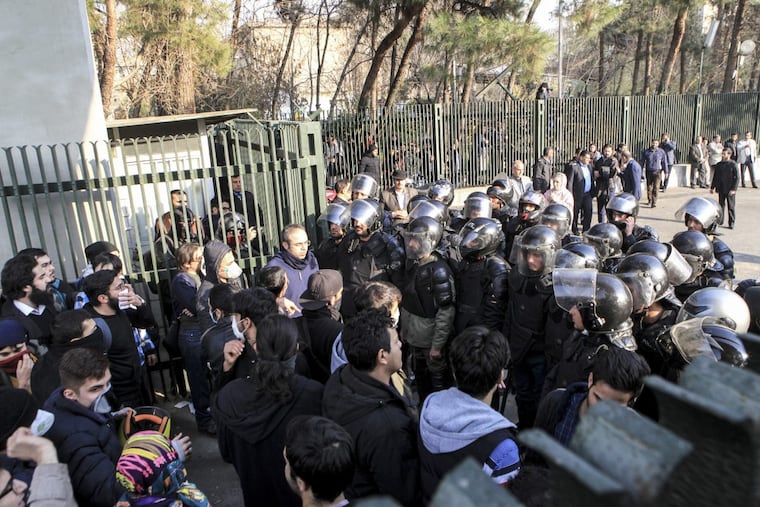Understanding the protests in Iran means digging much deeper than Trump's tweets | Trudy Rubin
Iranian protests stem from economic grievances amongst the working class and are unlikely to lead to revolution. Trump should approach them with care.

If you want to understand what has provoked days of protests in Iran and where they might be heading, I have some suggestions.
To truly comprehend the situation, you need to look beyond the headlines.
Since there are very few Western correspondents in Iran, you can find the richest trove of video and fresh information on Twitter (just not @realDonaldTrump). Check out the inimitable Carnegie Endowment fellow Karim Sadjadpour @ksadjadpour; intrepid Iranian-born journalists Maziar Bahari @maziarbahari, Farnaz Fassihi @farnazfassihi, and Borzou Daragahi @borzou; the Brookings Institution's Suzanne Maloney @MaloneySuzanne; and human-rights activist Gissou Nia @GissouNia.
To summarize their observations: These protests began with working-class youths in eastern Iran and have spread to Tehran and a host of smaller cities, including provinces inhabited by Kurdish and Arab ethnic minorities. The unrest reflects the economic and social woes of Iran's younger generation. But the demonstrations are leaderless and disconnected; they won't lead to a change of regime and if they turn more violent (or grow bigger) the regime will surely crush them.
There are things the West can do to warn Tehran off a violent crackdown. But a U.S. withdrawal from the nuclear accord with Iran and restoration of sanctions – both of which the president is mulling — would shift Iranians' blame for their economic troubles to the United States.
To understand the frustrations driving the young, working-class Iranians who began the protests, I recommend reading Shahram Khosravi's Precarious Lives: Waiting and Hope in Iran, published by the University of Pennsylvania Press. (A shorter version appears in the December 2017 issue of Current History.)
Whereas the Iranian revolution once claimed to champion the dispossessed, the poor are now considered a burden. The social safety net has shrunk due to falling oil prices, international sanctions, inflation, corruption, and reduced subsidies to the poor.
In 2015, official Iranian sources reported that 40 percent of the population lived below the poverty line, and unemployment among those 20 to 24 years of age was 25 percent (and some analysts say youth unemployment may reach 40 percent).
Among the working class, the rate of short-term and irregular employment tops 90 percent, writes Khosravi. In the meantime, "luxury shopping malls have mushroomed all over Tehran" and "the poor man is regarded as a failure and burden." Many Iranians who had reached middle-class standards are slipping backward.
"This poverty, unemployment, and unpaid salaries, this anger we see today," Khosravi told me by phone from Sweden, where he is a professor of anthropology at Stockholm University, "this is an accumulation of all the disappointments going on for a long time. Many young people are disappointed and see no future.
"Iranians were very hopeful [after the nuclear accord] that the economy would be improved and investment would come to the country, but Trump stopped all that, and they are disappointed. Who pays for that? The Iranian people."
Of course, the cause of Iran's economic troubles is also systemic.
The New York Times has reported that an initial catalyst for the public's anger was a leaked version of a proposed governmental budget. It included billions of dollars earmarked for the military and Islamic Revolutionary Guards Corps – with their costly ventures in Syria, Iraq, and Lebanon. Huge cash subsidies also go to religious foundations controlled by the clerical elite; the budget also proposed to slash subsidies for the poor and increase fuel prices.
Yet, there is little sign so far that the protests will lead to political upheaval, and the reasons go beyond the regime's monopoly of force.
Ordinary Iranians have bad memories of war and revolution. They are wary of the chaos in neighboring Iraq and in Syria. The government warns them that the United States and Saudi Arabia seek regime change. And Trump tweets underline the government's warnings.
So what should America do, or not do, to support the protests – or at least, to help avert a bloody crackdown?
I endorse Sadjadpour's suggestions – including careful U.S. statements of solidarity that support peaceful demonstrations and helping Iranians get the technology to circumvent regime internet blackouts.
Also, the White House should mobilize allies in Europe and Asia with whom Tehran wants greater trade to warn the ayatollahs against a massive crackdown. (If only Trump were interested in such a smart diplomatic strategy!)
I would add to this list that Trump should drop the ban on visas for Iranians to visit America. Nothing is more indicative of Trump hypocrisy than cheering the demonstrators while preventing visits from Iranian artists, scholars, and relatives of the large Iranian American population.
What should the United States NOT do: Incite protesters to revolution, as George H.W. Bush incited Iraqis to try to oust Saddam Hussein, before letting the dictator crush them. I doubt that Trump would take such advice. But, fortunately for them, Iranians now know the U.S. track record, and are unlikely to take Trump tweets any more seriously than they deserve.